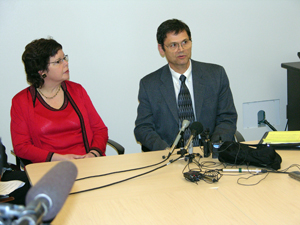 |
Stephen Rennard, M.D., answers questions from reporters on Monday during a news conference regarding President Barack Obama’s executive order on embryonic stem cell research. Monnie Lindsay, Nebraska coordinator for the Parkinson’s Action Network, looks on. |
Hope is necessary.
“When you’re getting up in the middle of the night to check your 4-year-old’s blood sugar, you have to have something to get you through that day to the next,” Bonness said. “Something that says the future holds something better.”
Bonness’ comments came moments after President Barack Obama — flanked by several prominent U.S. scientists — signed an executive order on Monday that overturned Bush administration restrictions on the use of federal funds for embryonic stem cell research.
Obama’s action brings hope, said Bonness, a former Nebraska and NFL football player whose sons are now 20 and 23.
Embryonic stem cell research has shown promise in the treatment of many diseases including diabetes, Parkinson’s disease and several other devastating conditions. The practice also has come under fire from opponents who claim it destroys embryos, and thus life.
Obama’s order will free up the use of federal funds to access stem cell lines created after Aug. 9, 2001, the day then President George W. Bush signed an executive order that limited the use of federal dollars for embryonic stem cell research.
The National Institutes of Health will now work to implement the changes called for in Obama’s order, which could take weeks or months, said David Crouse, Ph.D., associate vice chancellor for academic affairs at UNMC.
When the changes are in place, UNMC researchers will have access to the new federally approved stem-cell lines, he said.
“The change in federal policy … complements current state laws and Board of Regents policy regarding embryonic stem cell research,” Dr. Crouse said.
|
|
Obama’s order will allow federal funds to be used to access many more stem cell lines, including hundreds that have been created since Bush’s order that contain a higher quality of stem cell.
This means significant and rapid progress in embryonic stem cell research could be eminent, Dr. Crouse said.
“This is a big day for science,” said Dr. Crouse, who noted that science in the United States lagged because of the restrictions imposed by the Bush order.
Stephen Rennard, M.D., Larson Professor of Medicine in the Pulmonary and Critical Care Medicine Section at UNMC, is among the UNMC investigators who have used federally-approved embryonic stem cells in their work.
Embryonic stem cell research offers hope for unprecedented scientific progress, said Dr. Rennard, a leading researcher.
“This promise wouldn’t be realized, however, if the research isn’t pursued,” Dr. Rennard said, noting that Obama’s order opened the door for that hope to be reality.
It’s hope that resonates with those who suffer from Parkinson’s and other devastating diseases that embryonic stem cell research could help treat and cure, said Monnie Lindsay, Nebraska coordinator for the Parkinson’s Action Network.
Lindsay also suffers from Parkinson’s disease, which has kept her from her career as a lawyer.
“This is a great day for the 1 million plus Americans who have Parkinson’s disease and the millions of others who suffer from other diseases,” Lindsay said. “The research stands to help those who suffer. It could lead to new treatments, drugs and therapies and for that we are very excited.”